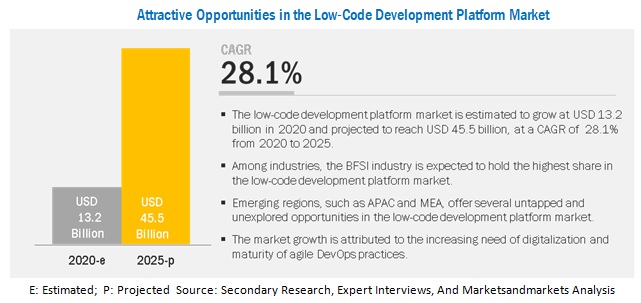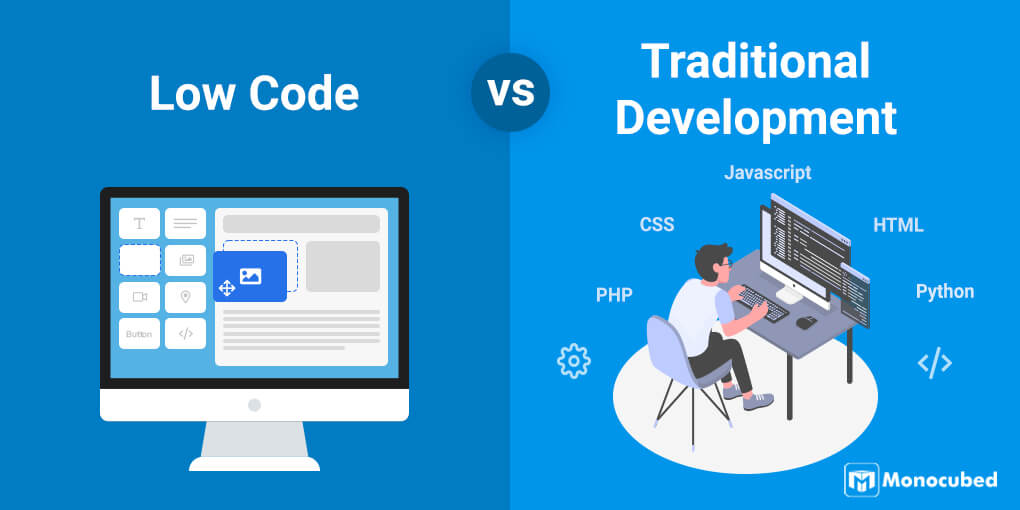Handy Advice For Selecting Low-code platforms for application development
Handy Advice For Selecting Low-code platforms for application development
Blog Article
The Accessibility Of Low-Code Applications Is One Of The Main Advantages.
Due to a range of important factors, Low-Code Application Development is available to people who are not developers. They are also referred to as "citizen designers."
Drag-and-drop Builders: Lowcode platforms provide drag-and-drop interfaces, which allow nondevelopers to visually create applications, without needing codes. This makes the development process easier for those with no technical backgrounds.
WYSIWYG Editors: "What You See Is What You get" editors enable users to design interfaces and workflows in a manner that closely resembles the final product, making it simpler to understand and use.
Simplified Design of Workflow Logic and Workflow:
Visual Workflow Modelling: Users can use visual workflow to develop business procedures, application logic, and flowcharts through diagrams and visual flowcharts. These methods are more intuitive than the traditional coding methods.
Pre-built Logic components Low-code platforms have logic components that have been pre-built (e.g. conditional loops and statements) that can be configured easily, reducing the requirement for complex coding.
Reusable Components and Templates
Libraries of pre-built templates: Many low code platforms provide a library that covers the most popular types of applications, allowing those who are not developers a base to build on and later modify.
Reusable Widgets and Modules: Users can use reused widgets and modules which can be created faster, reducing the time needed to create them and eliminating the need for in-depth technical knowledge.
Guided Development and Tutorials
Step-by-Step Instructions Platforms typically provide on-screen tutorials, guided development pathways, and other tools that help non-developers create applications.
Interactive Tutorials. Interactive, hands on tutorials let users learn by doing.
Integration with Tools Already in Use
Easy integration Low-code platforms have been designed to easily integrate with existing business systems and tools (e.g. CRM, ERP) permitting non-developers to create applications within their current workflows.
APIs Connectors: APIs are built into apps to facilitate integration. This allows non-programmers who do not have coding skills, to connect with external services.
Collaboration Features:
Team Collaboration: Features like real-time collaborative workspaces, as well as shared workspaces make it possible for non-developers to work effectively with developers, business analyst and other key stakeholders.
Role-based Access Control: Non developers are able to be assigned certain roles and access levels. This lets them participate in the development process without compromising security and functionality.
Automated testing and debugging
Low-code platforms include tools to test and debug that are built-in. They automatize the process so it is simpler for non-developers to ensure that their apps work.
Error Highlighting Whenever errors are detected, the platform highlights these and suggests solutions. It guides non-developers in troubleshooting.
Overall, the advantage of low-code application development for accessibility for non-developers is its capacity to make the development process more accessible. Low-code platforms offer intuitive, visual tools, guided user experiences, and allow business users to actively participate in creating, maintaining and updating applications. Follow the top I thought about this for more info including develop cross platform mobile app, application modernization software, mobile development platforms, azure sql databases, app dev platform, develop web application, developing mobile apps, application development platforms, build a docker container, push notifications android and more.
Benefits Of Low-Code Application Development In Terms Of Governance And Security
Low-code application development offers a variety of benefits for security and governance. It is crucial to ensure that apps comply with the rules, are secure, and are well managed throughout their life. Here are some of the main advantages:
Unified Management Console: A low-code platform typically provides a central dashboard for administrators to control and monitor all applications to ensure consistency in governance throughout the organization.
Role-Based Access Control (RBAC) The majority of these platforms offer robust role-based access control, allowing administrators to define and enforce access policies. This ensures that only authorized users can access or modify specific parts of an application.
Compliance and Regulatory Adherence
The advantages of conformity: Many platforms that use low-code are built to conform to industry standards. They offer tools and frameworks to ensure that the applications are compliant with these requirements.
Audit trails and logging: Comprehensive audit trails and logging are often connected. This lets companies keep track of access and changes, as well as to ensure compliance with internal regulations and external ones.
Increased Security Measures
Data Encryption. Low-code platforms usually have built-in encryption for data when in transit as well as during rest. This safeguards sensitive data.
Security Certifications A lot of low-code vendors have security certificates (e.g. ISO 27001, SOC 2 ) that demonstrate the compliance with security standards of high quality. This gives additional security to users.
Automated updates to ensure security:
Regular Patching and Updates: Lowcode platforms usually provide regular security updates. These patches protect applications against the latest threat without requiring developer intervention.
Security Monitoring: Constant security monitoring tools are included to provide real-time notifications as well as information about potential security concerns.
Data Governance:
Data Access policies These platforms allow organizations to define and enforce their data access policy and ensure only authorized users are able to access data and that it is properly used.
Data Masking Anonymization Data Masking Tools: Built-in data masking tools and features to anonymize data help protect sensitive data, particularly during testing and development environments.
Consistent application lifecycle management:
Pipelines for development and delivery: Low-code platforms typically include integrated pipelines for development and delivery pipelines that incorporate security tests. Security is assured throughout the lifecycle.
Version Control: A unified version control system helps to track changes and allows any modifications that are made to an application to be monitored. If required, these can be reverted and the integrity of the application maintained.
User Authentication Authorization
Single Sign-On (SSO). Support for advanced authentication and single sign-on makes it easier and increases security.
Multi-Factor Authentication: Many platforms have built-in support of multi-factor authentication. This provides an additional layer of security for applications.
Compliance Monitoring and Policy Enforcement Compliance Monitoring:
Policy Templates: Low code platforms usually have pre-defined templates for governance and security which allow companies to swiftly apply policies.
Compliance Monitoring Tools - These tools allow for constant monitoring of compliance status and provide reporting, making it easy to find and correct possible issues.
Integrate with the existing security infrastructure:
Seamless Integration: Platforms with low-code have been designed to seamlessly integrate with existing tools and infrastructure such as SIEM (Security Information and Event Management solutions) and firewalls.
API Security: Integrated API security ensures integrations with external system are secured. Protect data and maintain application consistency.
Training and best practices
Guided Best Practices: A number of platforms offer guidelines and best practices for developing secure applications and help non-developers comply with security standards.
Some low-code vendors offer security education to help users develop and maintain secure applications.
Low-code development can provide a range of governance and security benefits that help ensure that applications are created and maintained in a timely safe and secure manner. These platforms include the tools and frameworks needed to supervise and control process of developing applications, and safeguarding sensitive information while ensuring legal compliance and enforcing the policies. View the best Legacy application modernization with Low-code for website info including rapid action development, cloud software applications, rapid app development, push notifications, low code development platforms, application modernisation, developing mobile apps, mobile development platforms, azure sql databases, azure sql databases and more.
The Benefits Of Developing Low-Code For Workflow And Collaboration
It's an excellent choice for businesses that want to increase team productivity as well as streamline processes and enhance collaboration. These are the main benefits: Improved Cross-Functional Collaboration:
Unified Development Environment (UDE): Low code platforms create an integrated development environment that enables everyone in the team including developers as well as business analysts, to work together efficiently. This reduces the number of silos and enhances communication.
Visual Development Tools: The visual drag-and-drop design of low-code platforms makes it easier for non-technical team members be involved in the process of development, while ensuring that business requirements are accurately recorded and implemented.
Enhanced Communication:
Real-time collaboration: A lot of low-code platforms offer real-time communication capabilities, such as simultaneous editing and commenting. Feedback is instantaneously accessible. This can help reduce the time required for back and forth discussion.
Shared Workspaces: Teams can work together in shared workspaces, in which they can review, edit, and discuss project components, ensuring everyone's on the same page, and working towards shared goals.
A streamlined workflow management system:
Built-in Project Management Tools : Low-code platforms usually contain integrated software for managing projects that help teams plan, track, control, and coordinate their projects for development. This includes the assignment of tasks, monitoring progress, and managing deadlines.
Workflow Automated: The automation of routine work, workflows, as well as other processes reduces the manual effort required and reduces the chance of making mistakes. This lets teams concentrate on tasks that are more profitable and increases efficiency.
More efficient Iteration cycles
Rapid Prototyping: Low-code platforms facilitate rapid prototyping and iterative design that allow teams to design, test, and refine applications with shorter time. This provides rapid feedback and improvement.
Agile Development Support : Support for agile methodologies lets team members be involved in sprints. They can continue to deliver small improvements in functionality and easily adapt to the changing needs.
Accessibility to non-developers
Citizen Development: Low code platforms allow users in the business (citizens developers) to build and modify their applications without having a deep understanding of programming. This relieves IT and Development teams of burdens and gives them the ability to respond faster to business needs.
Training and Onboarding Simple interfaces and a wealth of training resources make it easier for new members of the team to learn the ropes improving the overall teamwork within the team.
Centralized documentation Knowledge sharing, dissemination and centralization:
Low-code platforms usually have the ability to create, maintain and storing documentation on their platforms. This allows the entire project's information to be stored in a central location and easily accessible.
Knowledge Repositories: Teams may develop and keep knowledge repositories, which include best practices, templates, and reuseable components, helping to facilitate knowledge sharing and reducing duplication of effort.
Consistency and standardization:
Standardized Components - The use of already-built, standardized components gives consistency between applications. It makes it simpler for the members of the team to comprehend the various components of a specific project and work on these components.
Governance and compliance: Integrated governance frameworks help ensure that development is in line with organizational standards and regulatory requirements. This lowers the risk of non-compliance, as well as helping applications comply with quality standards.
Feedback and Improvement Loops
Integrated Feedback mechanisms: Low-code platform typically have a built-in feedback mechanisms, which allow users to give their feedback on the application. Feedback can then become part of the development.
Continuous Improvement: The ability to quickly iterate and deploy modifications in response to feedback ensures the constant improvement of software. They are in close alignment to the requirements of users as well as business objectives.
Visualization of Reporting
Real-Time Analyses: Built-in reporting and analytics tools offer instantaneous insight into the project's performance, progress and user interaction, allowing to make data-driven choices.
Visual Workflow Analysis Visual tools are utilized to visualize workflows and processes. These tools help teams analyze and improve their workflows.
In terms of collaboration, low-code applications are a great way to streamline workflows, bring diverse teams together and automate tasks. This fosters a team-oriented environment with an agile and efficient process for development, which results in more high-quality apps as well as a better alignment between goals of business.